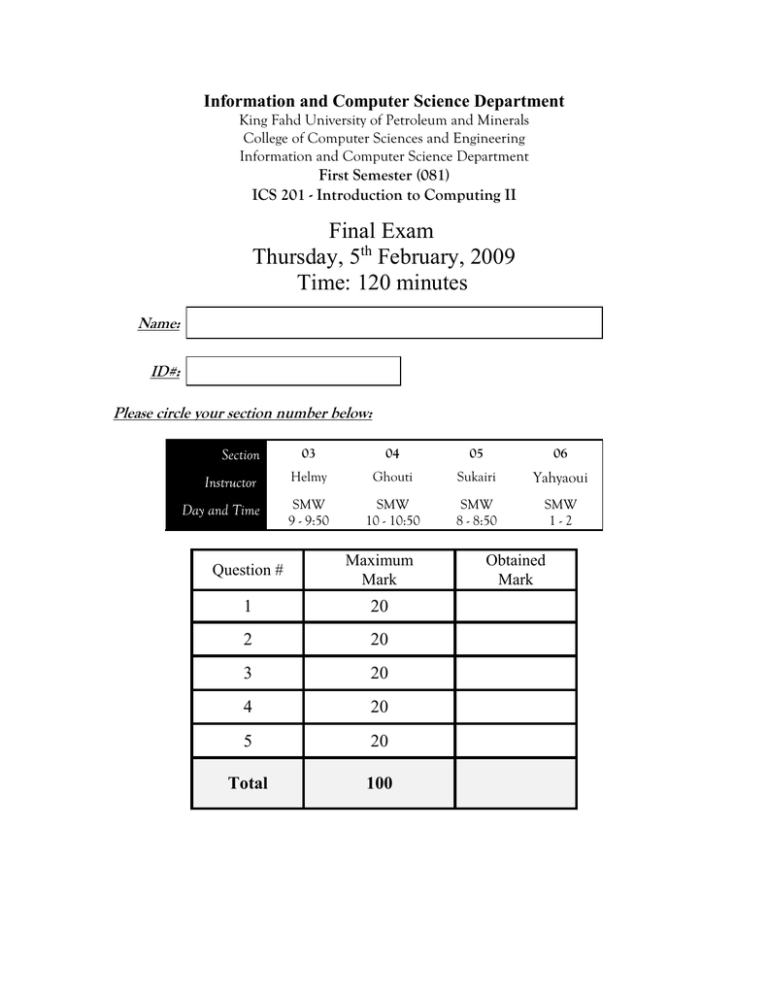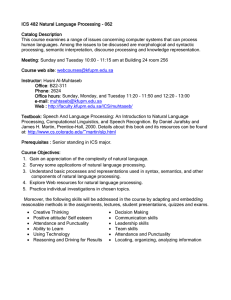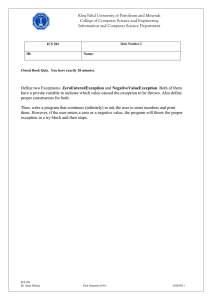Information and Computer Science Department
advertisement

Information and Computer Science Department
King Fahd University of Petroleum and Minerals
College of Computer Sciences and Engineering
Information and Computer Science Department
First Semester (081)
ICS 201 - Introduction to Computing II
Final Exam
Thursday, 5th February, 2009
Time: 120 minutes
Name:
ID#:
Please circle your section number below:
03
04
05
06
Instructor
Helmy
Ghouti
Sukairi
Yahyaoui
Day and Time
SMW
9 - 9:50
SMW
10 - 10:50
SMW
8 - 8:50
SMW
1-2
Section
Question #
Maximum
Mark
1
20
2
20
3
20
4
20
5
20
Total
100
Obtained
Mark
081
ICS 201 – Final Exam
Question 1
[20 Points]
Part I: True/False Questions
[10 Points]
1
Applets that are accessed on the net can access files on user’s PC.
2
The class loader of the java virtual machine allocates memory for the class
(i.e., static) variables and sets them to Java-default initial values during the
linking phase.
3
Processing raster graphics images is more efficient than vector graphics
images.
4
Method overriding is not allowed if the access scope is widened.
5
Protected is the access modifier for a class member variable which is to be
used in the same package where the class is defined.
6
Polymorphism allows changes to be made to method definitions in the
derived classes, and have those changes apply to the software written for the
base class.
7
Multiple inheritance is allowed for both classes and interfaces.
8
An inner class has access to private methods and instance variables of its
outer class.
9
A recursive method with no base case will run indefinitely.
10
If a class B extends class A, then class B can directly access all methods of
class A.
ICS Dept. - KFUPM
2
081
ICS 201 – Final Exam
Part II: Multiple Choice Questions
[10 Points]
2
1. When the point specified by the following vector notation: in the original vector
4
4
graphics image is moved to the point with coordinates , the following
16
transformation has occurred:
a. Translation by 2 in the X-axis and 4 in the Y-axis.
2 0
b. Uniform scaling by
0 2
0.5 0
c. Non-uniform scaling by
0 0.25
2 0
d. Non-Uniform scaling by
0 4
2. How can you prevent a class from being extended?
a. Declare a class static.
b. Declare a class private.
c. Declare a class protected.
d. Declare a class final.
3. What is wrong with the following recursive code?
int recursive(int n) {
if(n = = 0)
return 1;
else
return n + n-1;
}
a. There is no base case
b. There is no recursive step
c. Variable n should be declared as double
d. The method does not return any value
4. All of the following are methods of the Iterator interface except:
a. clear()
b. hasNext()
c. next()
d. remove()
ICS Dept. - KFUPM
3
ICS 201 – Final Exam
081
5. If class B extends class A, which of the following is false:
a. All fields and methods with protected accessibility are inherited.
b. All fields and methods with default accessibility are inherited.
c. Calling a constructor of class B will always call a constructor of class A.
d. Objects of type B are also of type A.
6. Which of the following is true:
a. A final class can not be instantiated.
b. A final method can be overloaded but not overridden.
c. Private methods are inherited by subclasses.
d. The instanceof operator checks whether a given object is an instance of
some class.
7. For polymorphism to work, certain things must be provided. Which of the following
is NOT one of them?
a. The reference type must be a super type of the object it references.
b. The reference type must be an interface or an abstract class.
c. The method called must be declared in the reference type and defined in
the object type.
d. Late or dynamic binding must be allowed.
8. Which of the following is NOT true about polymorphism?
a. By polymorphism, we get more general and flexible code.
b. In polymorphism, upcasting occurs automatically.
c. The return type of a polymorphic method must be void.
d. Polymorphism does not work for static methods.
9. Which of the following statements is true?
a. An interface can only contain methods
b. Interfaces can have some methods with empty implementations
c. A class may extend only one other class and implement only one interface
d. Interfaces are the Java approach to achieve multiple inheritance
10. What is true about inner classes?
a. Inner classes have to be instantiated only in the enclosing class
b. Inner classes can access all the final variables of the enclosing class
c. Inner classes cannot be static
d. Inner classes cannot be anonymous class
1
2
3
ICS Dept. - KFUPM
4
5
6
7
8
9
10
4
081
Question 2
ICS 201 – Final Exam
[20 Points]
Design and implement a Java program that uses an ArrayList of parameter type Book to
store a database of books. The Book class should store the book’s Title, Author, ISBN
and Price. The saved books are sorted in the database by ISBN.
Provide the Book class with all the necessary methods and write a Test class that shows:
How to add 5 books,
Do a search for a specific book and
Sort all the books in the database
Using the methods defined in the Collections (or Arrays) class (no need to implement
the search and sort methods, you can invoke them direct).
ICS Dept. - KFUPM
5
081
ICS Dept. - KFUPM
ICS 201 – Final Exam
6
081
ICS 201 – Final Exam
Question 3
Write a Java application that will produce the following GUI:
[20 Points]
Fixed Size
Closes Application
Width = 600
(40, 40)
JPanel
Rectangle:
Width = 60
Height = 60
Line Color = Red
Height = 600
JPanel
Background:
Cyan
The following actions should be handled:
1- Whenever the user clicks the mouse, the rectangle object gets repainted with the
upper-left corner specific by the click coordinates (x and y).
2- Whenever the user clicks the button labeled “Background Blue”, the whole
background becomes blue.
3- Whenever the user clicks the button labeled “Background Yellow”, the whole
background becomes blue.
4- Whenever the user clicks the button labeled “Reset Rectangle”, the rectangle gets
repainted at the upper-left corner coordinates given by: (40, 40).
5- The same actions should be handled by the menu items shown below:
ICS Dept. - KFUPM
7
081
ICS Dept. - KFUPM
ICS 201 – Final Exam
8
081
ICS Dept. - KFUPM
ICS 201 – Final Exam
9
081
ICS 201 – Final Exam
Question 4
[20 Points]
Write a program in Java which draws the following graphic. The specifications are given
below.
GUI
Specifications
(100, 100)
(170, 100)
(220,
150)
Font:
“Arial”,
Bold,
Size: 70
Board:
Red Color,
STOP:
White Color
Rectangle:
Gray Color
width = 20,
height = 100
The inside of the stop sign is a regular 8sided polygon with approximately equal
side lengths. Locations of three points are
given for ease of calculation.
ICS Dept. - KFUPM
10
081
ICS Dept. - KFUPM
ICS 201 – Final Exam
11
081
ICS 201 – Final Exam
Question 5
[20 Points]
Part I: Code Modification
[15 Points]
Consider the following Java application code. Provide the changes to make your code
work as an applet. You can omit and replace the existing code without rewriting.
import javax.swing.*;
import java.awt.*;
import java.awt.event.*;
public class Test_Final_Exam_081 {
public static void main(String[] args) {
new MyFrame();
}
}
class MyFrame extends JFrame implements MouseListener{
public MyFrame() {
setTitle("Playing With The Mouse!");
setSize(400, 400);
setResizable(false);
setVisible(true);
addMouseListener(this);
setDefaultCloseOperation(JFrame.EXIT_ON_CLOSE);
show();
}
public void mouseEntered(MouseEvent me) {
System.out.println("Mouse entered at: (" + me.getX() + ", " + me.getY() +")");
}
public void mouseExited(MouseEvent me) {
System.out.println("Mouse exited at: (" + me.getX() + ", " + me.getY() +")");
}
public void mouseClicked(MouseEvent me) {
System.out.println("Mouse clicked at: (" + me.getX() + ", " + me.getY() +")");
}
public void mousePressed(MouseEvent me) {
System.out.println("Mouse pressed at: (" + me.getX() + ", " + me.getY() +")");
}
public void mouseReleased(MouseEvent me) {
System.out.println("Mouse released at: (" + me.getX() + ", " + me.getY() +")");
}
} // End of MyFrame class
ICS Dept. - KFUPM
12
081
ICS Dept. - KFUPM
ICS 201 – Final Exam
13
081
ICS 201 – Final Exam
Part II: Applet Output
[5 Points]
What is the output of the following HTML file when run in an Internet browser (such as
IExplorer)?
<applet code = PaintingDemo.class width = "400" height = "400">
</applet>
The HTML file above makes reference to the following Java applet:
import javax.swing.*;
import java.awt.*;
public class PaintingDemo extends JApplet {
public static final int FRAME_WIDTH = 400;
public static final int FRAME_HEIGHT = 400;
private class APanel extends JPanel {
public void paint(Graphics g) {
super.paint(g);
setBackground(Color.YELLOW);
g.drawOval(FRAME_WIDTH/4,
FRAME_HEIGHT/6);
}
}
FRAME_HEIGHT/8,
FRAME_WIDTH/2,
public void init() {
getContentPane().setLayout(new GridLayout(2, 1));
APanel p = new APanel( );
getContentPane().add(p);
JPanel APanel2 = new JPanel( );
APanel2.setBackground(Color.WHITE);
getContentPane().add(APanel2);
}
}
ICS Dept. - KFUPM
14
081
ICS Dept. - KFUPM
ICS 201 – Final Exam
15




